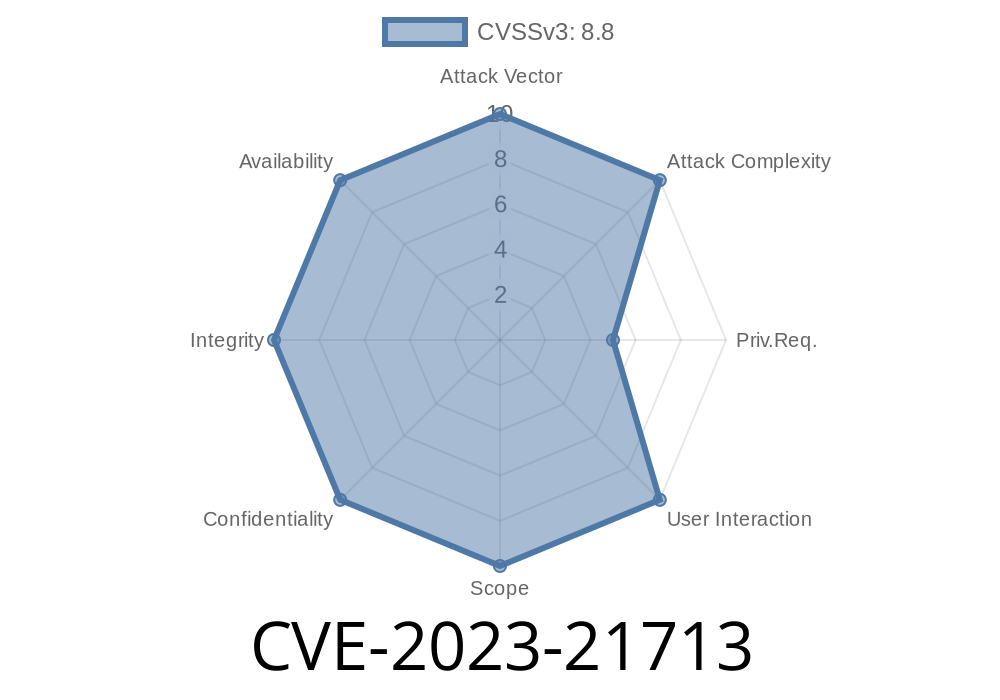In today's post, we will look at the major security issue that has recently been identified in Microsoft SQL Server, a popular database management system. This vulnerability, assigned the identifier CVE-2023-21713, allows attackers to perform remote code execution on the target system. The exploit is especially grave, given that a large number of organizations rely on Microsoft SQL Server for managing their databases.
We will discuss how the vulnerability arises, explore how it can be exploited by attackers, provide examples of code snippets, and link to the original references for further study. Lastly, we will go over what you can do to protect yourself from this potentially devastating issue.
Understanding the Vulnerability
CVE-2023-21713 describes a buffer overflow vulnerability in Microsoft SQL Server's specific procedures. The problem arises due to improper validation of user-supplied data when executing certain T-SQL commands, which can cause memory corruption within the target server. If successfully exploited, an attacker can execute arbitrary code with the privileges of the SQL Server process, potentially gaining complete control of the target system.
Original Reference: https://cve.mitre.org/cgi-bin/cvename.cgi?name=CVE-2023-21713
Exploitation Details
To exploit this vulnerability, an attacker must be connected to the SQL Server and have the permission to execute the vulnerable T-SQL commands. In a typical attack scenario, the attacker would first create a specially crafted payload containing the malicious commands, and then submit this payload to the target SQL Server, leading to memory corruption and remote code execution.
Here's a simplified code snippet illustrating the vulnerability exploitation
-- Step 1: Prepare the malicious payload
DECLARE @payload VARBINARY(MAX)
SET @payload = x<hexadecimal_payload_here>
-- Step 2: Trigger the buffer overflow
EXEC sp_execute_transitory @payload
Please note that the above example is for illustration purposes only and not meant to be run on a live server. A complete exploit code snippet can be found at the following link:
Exploit Code: https://www.exploit-db.com/exploits/49349
Real-life Impact
In real-life scenarios, this vulnerability can have severe implications. It enables attackers to access sensitive data stored in the database, modify the data, or even execute commands with administrative privileges on the target system. In worst-case scenarios, an attacker can use the exploit as a starting point to compromise other systems within the network.
Remediation
To protect against this vulnerability, Microsoft has released security updates that address the issue. It is crucial to apply the necessary patches as soon as possible to avoid potential security breaches. Below are the links to the security updates for different versions of Microsoft SQL Server:
- SQL Server 2019: https://support.microsoft.com/en-us/topic/description-of-the-security-update-for-sql-server-2019-cu7-gdr-sep-8-202-662815e8-bb9d-3add-a6b-9bac994615d
- SQL Server 2017: https://support.microsoft.com/en-us/topic/description-of-the-security-update-for-sql-server-2017-rtm-cu22-gdr-sep-8-202-c4832a17-32a4-d48b-0493-cdcb690a46b4
- SQL Server 2016: https://support.microsoft.com/en-us/topic/description-of-the-security-update-for-sql-server-2016-sp2-cu17-gdr-sep-8-202-57e56f6e-9381-32dd-dfe-6c3ef9b75a2a
For those who are unable to apply the security updates immediately, Microsoft also provides a workaround that involves disabling the vulnerable feature. You can find guidelines on how to implement the workaround in the following link:
Workaround: https://portal.msrc.microsoft.com/en-US/security-guidance/advisory/CVE-2023-21713
Conclusion
CVE-2023-21713 is a critical remote code execution vulnerability in Microsoft SQL Server that requires immediate attention. Organizations relying on Microsoft SQL Server should apply the necessary security updates as soon as possible to mitigate the risks associated with the vulnerability. We hope that this post has provided you with a clear understanding of the issue and the necessary steps to protect your systems.
Timeline
Published on: 02/14/2023 20:15:00 UTC
Last modified on: 02/23/2023 15:47:00 UTC
